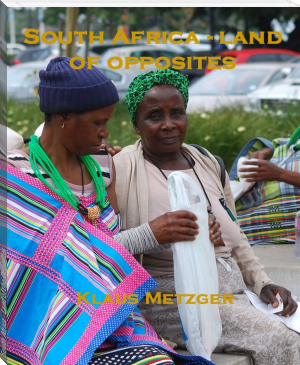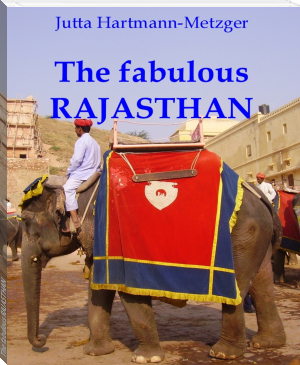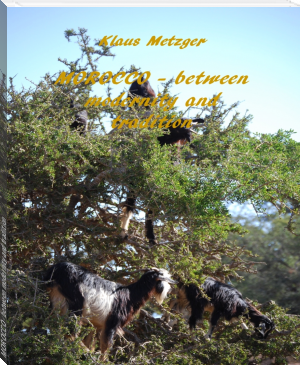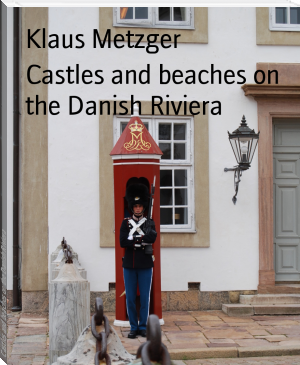South Africa - Land of the Opposites by Klaus Metzger, Jutta Hartmann-Metzger (phonics books .txt) 📕

- Author: Klaus Metzger, Jutta Hartmann-Metzger
Book online «South Africa - Land of the Opposites by Klaus Metzger, Jutta Hartmann-Metzger (phonics books .txt) 📕». Author Klaus Metzger, Jutta Hartmann-Metzger
Our African bungalow
We were looking forward to the bus trip from Johannesburg (A) on the highway to the east (on which you can get to Mozambique on the Indian Ocean). In Witbank we stopped at a larger gas station. There we were first introduced to the reality in South Africa, because our tour guide, Margot, warned against the crime, which is very common in the resting places. She called us an incident in which a bus driver of criminals was forced to open his bus with the gun, so that the robbers were able to search the valuables of the tourists (who were not in the vehicle) for valuables.
Margot also warned us before using the ATMs. It provided itself as protection in the money collection. We came out without the use of the ATMs - with one exception - since we had already been warned in Germany before. We had a larger amount in euros, which we successively changed in the banks or at the airport in Rand. This was a very time-consuming process (up to half an hour with the respective passport control and the filling in of numerous forms) - but gave us a sense of security.
The day before the return journey we needed a smaller amount as a tip for the guide in South African currency. With a queasy feeling and a colored coworker of the Capedonian hotel in Cape Town we went to the cash machine of the Mercantile Bank on the opposite side.We wanted 350 lift off. There was no money - just a document about the aborted process. The EC card remained in the machine. Jutta immediately went to the hotel to make the map in Germany block. I stayed at the vending machine to make sure that no one removed our card. In the meantime, a larger group of over 10 colored people had gathered in front of the machine. After a while, Jutta returned with the information that our tickets were blocked in Germany.
The following Monday, we immediately went to the Mercantile Bank at 9 am to complain about our missing EC card. From the bank employee we received our card immediately - however in the destroyed condition in numerous small parts.
Already in the morning at the opening of the machine this was carried out for safety reasons. Why was the card kept? Our EC card was not a Mastercard, but connected to the Maestro system. This was not accepted by the bankautomat. Why he did not return the card immediately, we remained a mystery. In Germany, we received new EC cards free of charge within one week - but with new pin numbers. So the whole (unnecessary) excitement had led to a good end.
To the east of Johannesburg is the small village of Springs, near which we crossed the bus. In this remarkable nest, Nadine Gordimer, the famous literary Nobel Prize laureate (1991), was born in the middle of the hills where gold was mined. In the context of her literary work, she critically discussed South Africa's politics of apartheid, and has repeatedly opposed publication prohibitions. I became aware of Nadine Gordiner in the family biography "The Cassirers" by Sigrid Bauschinger. The author devotes a whole chapter "Three Women" to Tilla Durieux and Eva Cassirer-Solmitz. Nadine Gordimer was married in second marriage to Reinhold Cassirer (his third partnership) since 1954. Cassirer was of Jewish descent and fled from Germany to South Africa in 1935. This relationship was ended by the death of Reinhold Cassirer on 17 October 2001. Nadine Gordimer was 16 years younger and died in 2014 in Johnannesburg.
The Pancake House in Dullstroom
I had already mentioned the place Lydenburg (since 2006 Mashishing), which we visited afterwards, in the first chapter: Lydenburg was one of the capitals of the Boer republics, founded up to 1844 (from 1856 to 1857). We stopped in Lydenburg because of the pharmacy there, as different travelers had to get drugs. My admiration was found by the South African family, who were on the trailer with the entire household, and were still making supplies at the shopping center in Lydenburg.
The Transporter of Lydenburg
After a long bus ride we reached the Blyde River Canyon. This canyon is breathtaking and ends in a large dam (Sidepost Dam). The Blyde River Canyon is 26 kilometers long and up to 800 meters deep. It consists mainly of red sandstone and is considered one of the great natural wonders of Africa.
Blyde River Canyon
Jutta Hartmann-Metzger at the Blyde River Canyon
Bourke' Luck Potholes
After a few minutes by bus, another scenic attraction reached the "Bourke's Luck Potholes" (D). These are located at the confluence of Treur and Blyde River, which have created the imposing canyons downstream. The water of these two rivers has created fascinating cylindrical holes, Bourke's Luck Potholes, made of dolomite rocks for millions of years. In the 1870s the place was discovered by Tom Bourke, who hoped for great gold cries. He also found gold, and this quickly spread. From several bridges the direct view into the holes and you can also close to the numerous waterfalls. We took the opportunity to look at the waterfalls a bit closer.
The inviting resort of INGWENYAMA Resort
The last section of our bus tour through the former province of Transvaal was less exciting and we were tired after 10 hours of tired looking forward to our unknown hotel INGWENYAMA Conference & Sports Resort, White River (E), South Africa. The first impression of this hotel was fascinating.
3. Wild animals - close up in South Africa
The elephant and the tree
After the long journey of more than three days we were very curious about the main attraction of South Africa, the Kruger National Park. Six years ago we had already participated in a two-day safari in the Tsavo East National Park in Kenya and loved it. After an extensive breakfast at the very pleasant INGWENYAMA Conference & Sports Resort, White River (A), South Africa, we took our coach to Numbi Gate to get to the Kruger National Park. The next day we should be taken back to the wild reserve by bus and then changed to open safari jeeps. The advantage of the jeeps was that we were able to stalk the wild animals even closer and over unspoilt slopes. By bus one was bound to the fortified streets and the photography was hampered by the windows.
"The Kruger National Park is a malaria area, especially during rainy winter months, the danger of contagion is increased and a thorough consultation with the tropics doctor is advised in advance, but medicines for malaraphylaxis are available in every South African pharmacy A medical prescription which is directed directly at the South African pathogens and is much cheaper than in Germany, as a rule tablets are taken daily. " This is what Wikipedia says. We were in the dry period (October) on the road and remained completely unmolested. This confirmed our decision not to take expensive malaria prophylaxis.
Kruger National Park at the Numbi Gate
A very good impression of the animal world and the wild reserve was given on the trip to the north-east Skukuza Camp (D). There is the center of the park and the headquarters. On the way we encountered shy zebras, antelopes and imposing giraffes. It was really interesting because of the numerous watercourses, as there were larger elephant herds. For the first time we were able to observe elephants from nearby, rubbing with pleasure on larger trees.
We spent the lunch break at the Skukuba Camp, where we were able to provide food for the lunch break, in addition to colorful souvenirs. This was the first opportunity to process the fantastic impressions of the South African animal world. Very impressive was the excursion to the river Sabie, after which the southeast camp is called Lower Sabie. We drove to the smaller Nkhuhlu (E) and went to the banks of the Sabie River. There was an opportunity to observe colorful birds and monkeys.
Shine Star
We left the Kruger National Park in the late afternoon over the Paul Kruger Gate (F). As we paused again, I was able to take some interesting discoveries nearby, which gave me a better idea of the history of the Kruger National Park. It was especially a Kruger monument, which I have already shown in the first chapter and seems to me to be worth seeing again.
Paul-Kruger monument
Paul Kruger came from German immigrants and was born 1825 in Cradock on the Cape. As the first of his ancestors the Jacobus Krüger from 1713 came to South Africa as a mercenary of the Dutch East India Company (VOC). The Kruger family was characterized by Calvinism. Already as an adolescent, Paul Kruger had to witness the consequences of the clashes between the Boers, to which his family belonged, and the British. At the age of ten, he took the gruesome and painful train of the Boers from the Cape Colony to the north, the "Great Treck".
The family settled down north of the river Vaal, where the town of Potchefstroom was founded. It lies today about 80 kilometers west of Johannesburg. Paul Kruger taught himself to read and write, and at the age of 16 he bought his own farm, which he called Waterkloof, 100 kilometers north of the parental seat. In 1842 he married his first wife, Maria, but she and her child died of malaria four years later. A year later he entered a new marriage with Gezina du Plessis, a cousin of his first wife, in which 16 children were born. In the exciting book "Death at the Cape" (story of the Burenkrieges) by Martin Bossenbrock (C.H.Beck publishing house) described the interesting biography of Paul Kruger from 1883 on.
Elephant under nature protection
After the first Burial War, he became President of Transvaal in 1883 and was also involved in legislation (he was himself an avid huntsman) to protect the wild animals. Thanks to his tireless efforts, the area between Sabie River and Crocodile River was declared a Sabie Game Reserve in 1898. This was the development of today's Krugerpark.
Friends after the safari in the





Comments (0)